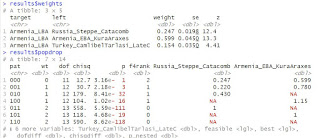Genetic history of Levant. Part A.
Recently there was a surge of interest in Levantine genetics, so here is a summary of Levant genetic history in two parts
Natufian culture (13000-9000BC) a hunter gatherer society which has a remarkable feature of being sedentary or semi sedentary. Archaic E1b and CT haplogroups.
Levant Neolithic (9000-4500BC) is divided in two parts. Pre Pottery Neolithic (PPN) and Pottery Neolithic. Spread of farming to south Levant from more northern regions. The core region of farming invention was in Urfa region ( Portasar / Gobekli tepe ) near modern Syrian Turkey border. You can see on the chart an important shift to north in autosomes during this period in south Levant ( Israel , Jordan PPNB ). A best proof of this scenario is the haplotype E1b-Z1919 which has two important branches. One E-L618 moved to Europe via Anatolia and today is popular in Balkans. The other parallel branch E-V22 moved to Egypt introducing farming there. It is popular today in north Egypt. Another important lineage from this period is the E-M123 mostly found today in West Asia even though it moved to Central Asia also. Sporadic apparition of H2 and T1a.
Copper Age - Chalcolithic ( 4500-3300BC) there are no much samples from this period. The few cases from a period close to Ghassulian culture show another shift in autosomes toward north Iraq. Consistent with the archaeological records showing emergence of new burial tradition. Currently it's hard to pinpoint the exact cultural phenomenon that triggered this shift in Chalcolithic south Levant. The similar shift toward north Mesopotamia started in north Levant (Tell Kurdu) earlier. The plausible candidate is the Halaf culture. The T1a1a-L208 in this period is also favoring the theory of involvement of new groups not directly descending from Neolithic period.
Early Bronze Age (3300-2200BC) the end of Chalcolithic and the start of Bronze Age in Levant is a period of dramatic changes in material culture. Old settlements are abandoned and new mobile pastoralist groups spread all over Levant. Those are the early Semitic tribes. The change in autosomes is subtle, more eastern but the change in Y DNA in Levant EBA is drastic. The E1b shrinks and the J1-Z1853 is the most popular haplotype starting from this period. J2b1 also shows an important increase in this period. Where was exactly located the Proto Semitic homeland is debated. It is usually placed in Arabian peninsula. The slight increase of Natufian ancestry do favour a southern location. But the surge of ancestry related to historic Armenia force to imagine a region close to Mesopotamia (see the map) A region where J1 must have been present since older periods. J1 is ultimately from more northern Taurus-Zagros-Caucasus mountains.
Currently the ancient DNA is insufficient to locate precisely the Proto Semitic homeland and the path of J1 migration.
Wherever the Proto-Semitic homeland was located they expanded to north reaching Taurus mountains and to east reaching Zagros mountains. In the south they crossed Red sea and landed in Ethiopia around 1000BC. The first branch in Semitic family is the East Semitic represented by Eblaite and Akkadian. Both extinct today. They settle in north Levant and Mesopotamia where their culture merged with the Sumerians and apparently put end to Uruk culture at 3100BC. Akkadians created one of oldest empires, uniting Mesopotamian city states around 2330BC which collapsed around 2150BC.
After the 2200BC climatic event and the demise of Akkadian empire new period starts in Levant which will be discussed in Part B














